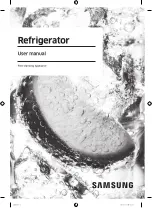
7–1
T-368
SECTION 7
SERVICE
NOTE
Use a refrigerant recovery system whenever
removing refrigerant. When working with
refrigerants you must comply with all local
government environmental laws. In the
U.S.A., refer to EPA section 608.
WARNING
!
EXPLOSION HAZARD: Failure to follow
this WARNING can result in death, serious
personal injury and / or property damage.
Never use air or gas mixtures containing
oxygen (O
2
) for leak testing or operating
the product.
Charge Only With R
−
134a: Refrigerant
must conform to AHRI Standard 700
specification.
7.1
SECTION LAYOUT
Service procedures are provided in this section begin-
ning with refrigeration system service, then refrigeration
system component service, electrical system service,
temperature recorder service and general service. Refer
to the Table of Contents to locate specific topics.
7.2
MANIFOLD GAUGE SET
The manifold gauge set (see
) is used to
determine system operating pressure, add refrigerant
charge, and to equalize or evacuate the system.
Figure 7.1 Manifold Gauge Set
When the Suction Pressure Valve is frontseated
(turned all the way in), the suction (low) pressure can
be checked at the Suction Pressure Gauge.
When the Discharge Pressure Valve is frontseated, the
discharge (high) pressure can be checked at the Dis-
charge Pressure Gauge.
When both valves are backseated (all the way out),
high pressure vapor will flow into the low side.
When the Suction Pressure Valve is open and the Dis-
charge Pressure Valve is shut, the system can be
charged through the Utility Connection. Oil can also be
added to the system.
A R-134a manifold gauge/hose set with self-sealing
hoses (see
) is required for service of the
models covered within this manual. The manifold
gauge/hose set is available from Carrier Transicold.
(Carrier Transicold P/N 07-00294-00, which includes
items 1 through 6,
If the manifold gauge/hose set is new or was exposed
to the atmosphere, it will need to be evacuated to
remove contaminants and air as follows:
1. Backseat (turn counterclockwise) both field ser-
vice couplings (see
) and midseat
both hand valves.
2. Connect the yellow hose to a vacuum pump and
refrigerant 134a cylinder.
3. Evacuate to 10 inches of vacuum and then
charge with R-134a to a slightly positive pres-
sure of 0.1kg/cm
2
(1.0 psig).
4. Frontseat both manifold gauge set valves and
disconnect from cylinder. The gauge set is now
ready for use.
Utility Connection to:
A. Refrigerant cylinder
B. Vacuum Pump
C. Oil Container
Discharge Pressure
Gauge
Suction Pressure
Gauge
Suction Pressure
Valve
(shown frontseated)
Low Side
Connection
High Side
Connection
Discharge Pressure
Valve
(shown backseated)
Downloaded from
Summary of Contents for 69NT40-541-505
Page 2: ...Downloaded from ManualsNet com search engine...
Page 4: ...Downloaded from ManualsNet com search engine...
Page 10: ...Downloaded from ManualsNet com search engine...
Page 14: ...Downloaded from ManualsNet com search engine...
Page 18: ...Downloaded from ManualsNet com search engine...
Page 80: ...Downloaded from ManualsNet com search engine...
Page 86: ...Downloaded from ManualsNet com search engine...
Page 92: ...Downloaded from ManualsNet com search engine...
Page 124: ...Downloaded from ManualsNet com search engine...
Page 125: ...Downloaded from ManualsNet com search engine...
Page 126: ...Downloaded from ManualsNet com search engine...
Page 142: ...Downloaded from ManualsNet com search engine...
















































